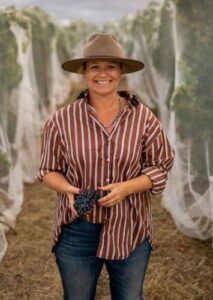22 February 2024
The AWRI helpdesk has received reports of crown gall-like symptoms affecting young vines in a number of regions in Australia.
Preliminary analysis conducted by laboratories in NSW and Victoria has suggested the presence of Agrobacterium species from the biovar 1 group in the galls. This finding is unexpected given that the predominant causal agent for crown gall disease historically in Australian vineyards has been Allorhizobium vitis (previously referred to as Agrobacterium vitis), which belongs to the biovar 3 group. While Agrobacterium species from the biovar 1 group have not previously been associated with crown gall disease in Australian vineyards, they are known to induce similar symptoms in other plant species, including pome fruit, stone fruit and nut trees.
Agrobacterium and Allorhizobium species are commonly found in soils and water worldwide, where they typically lead saprophytic lives, surviving independently of a host. However, when they infect plants, they can either be non-pathogenic or act as pathogens, causing diseases. Pathogenicity is linked to virulence genes on a tumour-inducing plasmid (Ti plasmid). Among the known strains of Agrobacterium from the biovar 1 group, some exhibit pathogenicity towards plants while others do not. Testing is currently underway on vines displaying the crown gall-like symptoms, to determine the specific strain(s) present. Once identified, further investigation will be necessary to demonstrate whether or not these strains are pathogenic towards grapevines.
Symptoms
The symptoms that have been reported are gall formation at wound sites, stunted growth, peeling and cracking of bark, as well as a gradual decline in vine vigour and vine loss due to girdling as the disease progresses. Young vines are particularly vulnerable as galls can impede water and nutrient flow throughout the vine. Frost injury causing cracking of the bark has led to small tumours forming in a line along the cracking wound. Symptoms of crown gall can also be mistaken for those of vine strangulation around the graft union and root knot nematodes.
Response
In response to this issue, a group of representatives from industry bodies including the AWRI, Wine Australia and Vinehealth Australia, diagnostic laboratories, the propagation sector, research organisations, state biosecurity bodies and growers are working together. This group aims to identify the causal organism(s) of crown gall-like symptoms in affected vineyards, identify the source of infection, and establish best practice management guidelines for infected vineyards.
Efforts are also currently underway to align and enhance diagnostic techniques for identifying Agrobacterium and Allorhizobium species across multiple Australian laboratories.
Vineyard hygiene
There are currently no effective and practical methods available for completely eradicating crown gall once the bacteria are established in a vineyard, primarily due to their ability to persist in the soil for extended periods. Until more information becomes available, growers are strongly advised to adhere to best-practice farm gate hygiene. Given the potential spread of Agrobacterium and Allorhizobium bacteria through contaminated soil, water and equipment, strict hygiene measures are imperative to minimise the risk of spread. These measures include segregating vineyard activities between clean and diseased blocks, regularly disinfecting tools and equipment in contact with soil or vines, preventing the transfer of soil or plant debris between blocks, and ensuring contaminated water does not flow into clean areas or water storage facilities.
Vinehealth Australia provides a list of ‘Top farm-gate hygiene activities’ and protocols outlining procedures for disinfecting footwear or small tools, and harvester cleaning. While these are primarily aimed at minimising the introduction of phylloxera, it is important to note that for farm gate hygiene disinfestation procedures to be effective, they must address the target pest, disease or pathogen. The latest recommendation to target crown gall is to use undiluted methylated spirits (95% ethanol) to disinfest footwear and small hand tools. Growers using ethanol in footbaths are advised to follow a two-step process to ensure footwear is first cleaned of all soil and plant material, prior to submersion in the ethanol for 60 seconds, with no water rinse thereafter. The efficacy of the ethanol will be prolonged by covering the footbath securely during daylight hours when not in use to prevent degradation, and replacing the ethanol at least daily or more frequently if it becomes soiled. This disinfestation procedure is also effective against phylloxera. Note that caution is advised because 95% ethanol is highly flammable.
What to do if you observe gall-like symptoms:
- Photograph and document the location of affected vines.
- For new vine plantings, contact your nursery supplier and the Vine Industry Nursery Association (VINA) on 0429 772 221 or steve@armnursery.com.au.
Contact the AWRI helpdesk on 08 8313 6600 or helpdesk@awri.com.au for advice on options for testing and identification.
Acknowledgments
The AWRI’s eBulletin is supported by Wine Australia, with levies from Australia’s grapegrowers and winemakers and matching funds from the Australian Government. The AWRI is a member of the Wine Innovation Cluster in Adelaide, South Australia.
Suzanne McLoughlin from Vinehealth Australia is thanked for her contributions to this eBulletin



